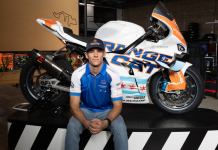Posted by David Swarts
Editorial Note: The following is from MotoAmerica Technical Bulletin 01-2019.
MotoAmerica approved “Superbike Kit”
The MotoAmerica approved “Superbike Kit” system will be based on the MoTeC M130 hardware. The firmware was designed by MoTeC UK and will be sold as a complete package including all activation codes, software, ignition drivers, lambda sensor, color display/logger at a reduced cost. Due to the special pricing and specifications provided by MotoAmerica the ECU will be locked and no other licenses will be available. The total cost is $5852.44 + tax and will be available for purchase at any US MoTeC dealer. The units will receive a special part number (TBA) and will be available for purchase January 1, 2019. Replacement parts are available at normal retail price.
FIRMWARE SUMMARY
MoTeC’s Mid Level Superbike M1 ECU firmwares are based on the 2019 British Superbike Championship firmwares, but with the addition of extra rider aids (traction control, anti-wheelie, launch control and closed loop fueling) and the removal of certain BSB specific limitations (maximum engine speed limit, scrutineer logging, advanced security).
The packages allow for fully flexible operation of most four cylinder port injected motorcycle engines fitted with drive by wire systems. Apart from engine control, the packages also provide various rider aids, in line with the championship rules.
There are specific firmwares for each individual make and model that is entered into the championship. All firmwares are broadly similar, with only small differences from bike to bike according to the base model hardware specification.
GENERAL FEATURES
Operates four cylinder port injected engines with two injectors per cylinder.
Support for in-line or vee configurations.
Supports stock engine synchronization methods i.e. cam sensor, intake depression.
Odd-fire engines supported.
FUEL FEATURES
Pulse volume fuel model (n/alpha).
3 axis Fuel Volume Main table (Engine Efficiency v Engine Speed v Driver Fuel Volume Main Switch).
Fuel compensation tables for Coolant Temperature, Airbox Temperature and Airbox Pressure.
Pulse compensation tables for primary and secondary injector interaction.
Throttle rate of change transient fuel calculation.
2 axis individual cylinder trim tables (Engine Efficiency v Engine Speed).
Closed loop fuel control based on a single lambda input
IGNITION FEATURES
3 axis Ignition Timing Main table (Engine Load v Engine Speed v Driver Ignition Timing Main Switch).
Ignition compensation tables for Coolant Temperature, Airbox Temperature and Gear.
2 axis individual cylinder trim tables (Engine Load v Engine Speed).
Knock control.
CONTROL FEATURES
Up to two drive by wire motors with 2 axis grip translation table for each gear (Throttle Grip Sensor v Engine Speed) and minimum positions from engine braking strategy and idle table.
Support for exhaust servo motors.
Top level gear shift strategy for upshifts and downshifts.
Variable intake length control (BMW, Ducati, Yamaha).
Variable fuel pressure control (BMW).
RACE FEATURE
Engine braking control via drive by wire minimum position. Open loop component for each gear (Engine Speed Calculated v Gear) and closed loop component based on target rear wheel slip (P controller).
Launch control via ignition retard, engine speed limiting and throttle limiting. Activation based on throttle grip threshold and de-activation based on exit gear.
Traction control via front and rear wheel speed comparison and aim slip. PID controller based on aim slip error. Power reduction by means of ignition cut or ignition retard.
Anti-wheelie control intrinsic to traction control strategy. Wheelie state is determined using suspension position, state then determines whether to apply additional gain and minimum power reduction tables.
Engine Overrun Fuel Trims selectable for individual cylinders.
Lean angle determination via IMU, GPS or sensor.
Lap timing via MoTeC BR2, switched input or GPS.
SLM support.
Rain light support.
Tilt switch feature.
SUPPORTED NON-ENGINE SENSORS
Brake Pressure Front/Rear.
Clutch Position and Pressure.
GPS via CAN.
Multiple IMUs (Bosch MM5.10, E Lean, Yamaha R1).
Steering Damper Position.
Suspension Position Front/Rear.
Wheel Speed Front/Rear.






